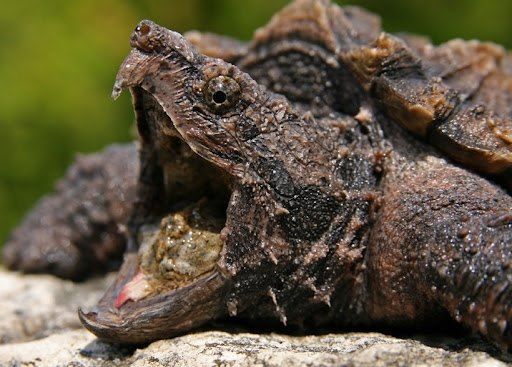Here's What You Need To Know About Snapping Turtle..
| Tweet |
Here’s what you need to know about Snapping turtles!
Snapping turtles are mostly-aquatic freshwater turtles. They spend majority of their time in water but only nesting females will go to land to lay eggs and they are solitary reptiles, except during mating season, of course ![]() As ambush feeders, snapping turtles prefer water with sandy-muddy bottoms and a lot of vegetation where they can easily hide or bury themselves in, with only their nostrils and eyes exposed, motionless. There are two types of snapping turtle i.e. common snapping turtle and alligator snapping turtle.
As ambush feeders, snapping turtles prefer water with sandy-muddy bottoms and a lot of vegetation where they can easily hide or bury themselves in, with only their nostrils and eyes exposed, motionless. There are two types of snapping turtle i.e. common snapping turtle and alligator snapping turtle.
Common snapping turtle has an oval-shaped head, a smooth shell and a flat-fleshy tongue while alligator snapping turtle has a triangular-shaped head, a spiky shell and a worm-like growth on the tip of its tongue, that is used to lure prey. They both have long and sharp claws, a powerful bite and a beak that is design to tear meat! Similar to sea turtles, snapping turtles are also uncapable of hiding its head and limbs into its shell.
“Are snapping turtles dangerous?”
Despite their reputation for being aggressive and its intimidating appearance, snapping turtles typically would avoid human contact when encountered in water. On the other hand, when they are encountered on land, snapping turtles tend to get more defensive as they feel more vulnerable, especially the nesting females. However, they are unlikely to attack if unprovoked. Needles to say, snapping turtles and other turtle species, will only strike when they feel threatened, as self-defense. Otherwise, they are harmless and enjoy minding their own business.
📸: Ryan M. Bolton
#turtlefacts #funfacts #DidYouKnow #thingsyoudontknow #snappingturtles #turtlegram #turtle
Here’s what you need to know about Snapping turtles!
Snapping turtles are mostly-aquatic freshwater turtles. They spend majority of their time in water but only nesting females will go to land to lay eggs and they are solitary reptiles, except during mating season, of course ![]() As ambush feeders, snapping turtles prefer water with sandy-muddy bottoms and a lot of vegetation where they can easily hide or bury themselves in, with only their nostrils and eyes exposed, motionless. There are two types of snapping turtle i.e. common snapping turtle and alligator snapping turtle.
As ambush feeders, snapping turtles prefer water with sandy-muddy bottoms and a lot of vegetation where they can easily hide or bury themselves in, with only their nostrils and eyes exposed, motionless. There are two types of snapping turtle i.e. common snapping turtle and alligator snapping turtle.
Common snapping turtle has an oval-shaped head, a smooth shell and a flat-fleshy tongue while alligator snapping turtle has a triangular-shaped head, a spiky shell and a worm-like growth on the tip of its tongue, that is used to lure prey. They both have long and sharp claws, a powerful bite and a beak that is design to tear meat! Similar to sea turtles, snapping turtles are also uncapable of hiding its head and limbs into its shell.
“Are snapping turtles dangerous?”
Despite their reputation for being aggressive and its intimidating appearance, snapping turtles typically would avoid human contact when encountered in water. On the other hand, when they are encountered on land, snapping turtles tend to get more defensive as they feel more vulnerable, especially the nesting females. However, they are unlikely to attack if unprovoked. Needles to say, snapping turtles and other turtle species, will only strike when they feel threatened, as self-defense. Otherwise, they are harmless and enjoy minding their own business.
📸: Ryan M. Bolton
#turtlefacts #funfacts #DidYouKnow #thingsyoudontknow #snappingturtles #turtlegram #turtle
Source: https://www.facebook.com/TurtleConservationSocietyofMalaysia..
| Tweet |

Facebook Comments